Jellyfish: The Perfect Resource for High Quality and Fashion Leather - from Waste to Resource
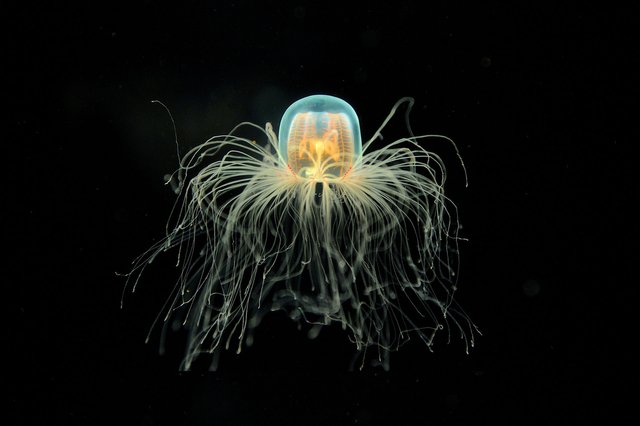
With the increase of standard of living throughout the world, the demand for luxurious products is also increasing and with that the demand for leather. We also are getting more environmentally aware. Traditionally we use leather from animals like cows, pigs, goats and other land animals. The skin of these animals consist of high levels of collagen, a fibrous protein held together by chemical bonds. It is this collagen that has all the properties that we know from leather. To create leather requires essentially a process to dissolve fats and nonfibrous proteins and strengthen the bonds between the collagen fibres.
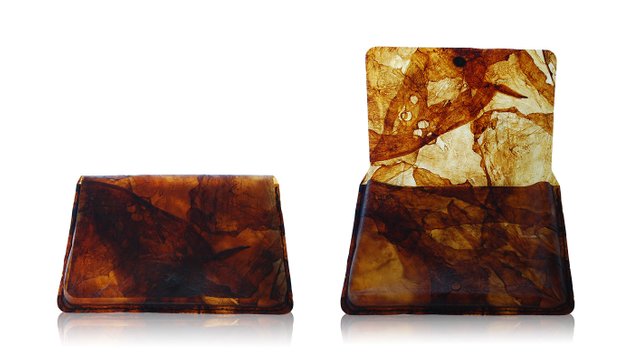
When Yurii Kasao, a Japanese design-products graduate from London’s Royal College of Art, learned about the requirements for quality leather, she started to research alternative sources. She discovered jellyfish consists of water and high levels of collagen and has perfect properties to be the source for high grade leather.
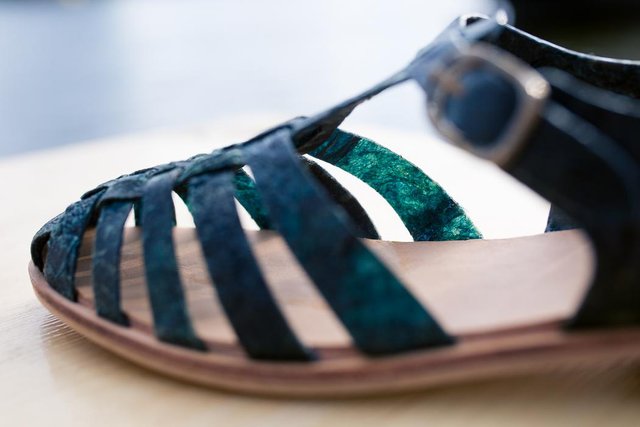
While Yurii Kasao focused on creating high fashion handbags, Dutch 27 year old Charlotte van Alem created together with her teacher at the Dutch Shoe Academy - Liesel Swart – the first prototype shoe from jellyfish leather. She was inspired by the enormous amounts of dead jellyfish in the Baltic. She is highly motivated to research further and aims to come up with an effective collection and production process for jellyfish based leather for commercial products. The next step Charlotte is taking, is to research the huge jellyfish that can become as big as 3 meter in diameter, found in Japanese waters.
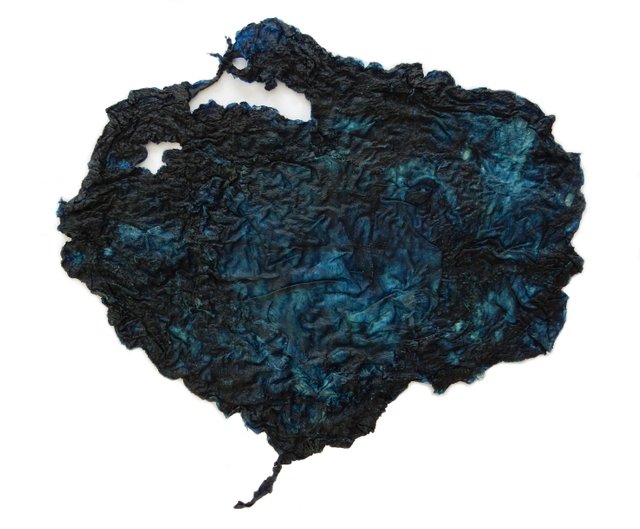
Why jellyfish are such a great resource of leather?
- Jellyfish can have beautiful colours and patterns
- Jellyfish leather can be cut, sewn, and remolded just like cow leather, without the need for toxic and environmentally destructive tanning processes
- Large amounts of dead jellyfish are in our seas and oceans and on our beaches
- A potential way to control the numbers of a venomous invasive species that wreaks destruction on marine life and ecosystems
- Enormous amount of jellyfish are in our oceans and the population is growing by the day
Some company developed a jellyfish shredder that can be used in the water to support protecting our marine life. Both Yurii and Charlotte find such 'cleaning' of our waters of dead jellyfish a waste of resources. And so shall we all think in my honest opinion!
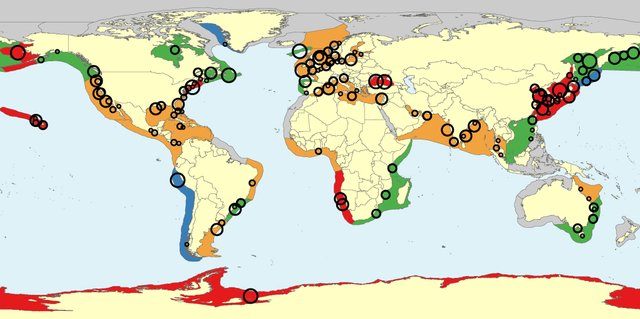
Image Legend
- Red: increase of population
- Orange: likely increase of population
- Green: stable population
- Purple: decrease of population
- Grey: not data available
- Rings: the larger the ring size the more certain the data
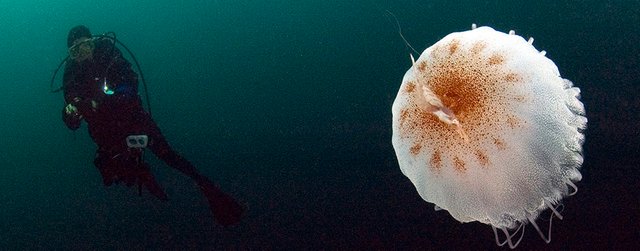
What are jellyfish?
Jellyfish are lacking brains, blood, or even hearts, jellyfish are pretty simple critters. They are composed of three layers: an outer layer, called the epidermis; a middle layer made of a thick, elastic, jelly-like substance called mesoglea; and an inner layer, called the gastrodermis. An elementary nervous system, or nerve net, allows jellyfish to smell, detect light, and respond to other stimuli. The simple digestive cavity of a jellyfish acts as both its stomach and intestine, with one opening for both the mouth and the anus.
Jellyfish have the ability to sting with their tentacles. While the severity of stings varies, in humans, most jellyfish stings result only in minor discomfort.
I didnt even know you could make leather out of jellyfish. You learn something new everyday
A day is not lived when not learned something new :)
Another good example of a female dutch thorough and sustainable entrepreneur(ship) that could be very succesful.
But boy oh boy, what a bad breath those jellyfish must have, haha.
LOL
Gaaf weer iets nieuws geleerd vandaag :) Dank je @edje !
Ik had geen idee dat je van jellyfish leer kon maken :)
Super inderdaad! :)
wow we have millions of them in the local river system and it would be awesome to make a product from the leather- Am happy to follow you in support
Millions, even Billions and growing in population day by day. The idea is to collect all the dead ones in the oceans and seas and at the beaches. Free sources without killing anything.
great resource
It sure is :)
That's incredible! You always find the most interesting topics
I really like science and what it can do to create new practical things; Somehow my brains are focused on this, unconsciously. I think I picked this one up some time ago when listening to our Dutch business news radio when this Charlotte girl was interviewed.
This is really awesome - I'm not sure how durable this material is, but in terms of the confluence of factors leading towards the use of jellyfish leather, it couldn't be more apropos. Resteemed and followed.
The shoes seem to work and those have to do quite heavy work while using. To get the jellyfish leather for shoes strong, Charlotte applied many layers of jellyfish leather on top of each other. This also then gives the interesting looks. BTW, collagen when applying the process of making leather, ie taking all the other stuff that sits in the skin of an animal, and apply stuff to make the binding of the collagen stronger, results in very string material. Collagen has the properties that by nature it already creates string connections amongst the molecules. In addition it is very durable, think of your own skin how durable it is, and how flexible and all. Collagen from jellyfish is not different. The challenges are more in how to collect the dead jellyfish, and how to transport it to the location where it'll be further processed, as well as to make the leather making process as efficient as possible to be able to compete with the prices of the leather coming from cattle.
Given the long gestation period of cattle compared to jellyfish, I think they're already well on their way !
They really only need to refine the harvesting and treatment processes, and then get some marketing on the job. An ecological alternative to leather looking like this is sure to be a crowd-pleaser.
Thank you, I truly think such alternative ways of getting to quality leather will be licked by more and more people over time. Another method is using fish skin. I'll create a blog about this sometime in the future.
Humans ain't so simple a critter, we have ingenuity... hopefully the trend escalates in smart and ever expanding basis!
Beautifully stated!
wow nice and useful post
Thank you
genius idea
Absolutely! :)
what a informative post.. content is awesome.. i even don't know leather can be make from jellyfish.. I learn a lot.. thank you so much
You're Welcome and Thank You :)